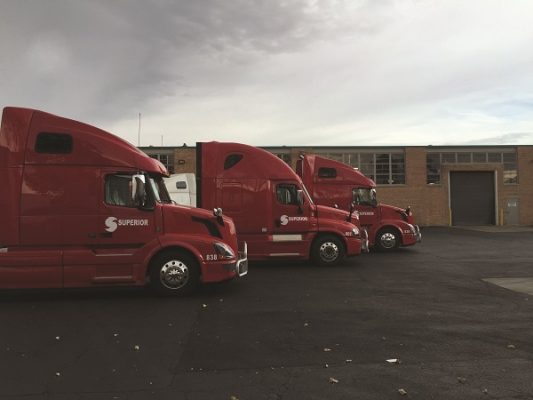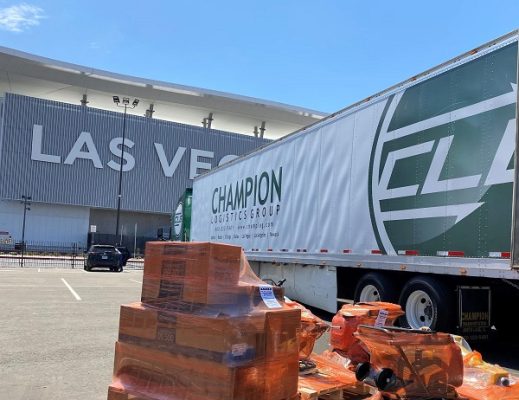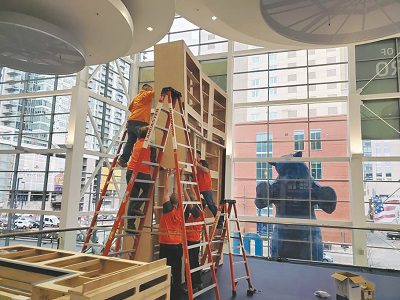Tradeshow Transportation: Forging New Links in the Supply Chain
By H. K. Wilson
According to the American Trucking Association, truck drivers move, on average, 11.84 billion tons (roughly 80 percent) of our nation’s freight annually. During the pandemic, these frontline heroes ensured that food, medical supplies, building materials and other necessities continued to reach every corner of the country. They kept the wheels of society turning long before we knew just how dangerous COVID would prove to be and well in advance of available vaccines.
Imagine spending long hours alone on the road with only the radio for company, navigating inclement weather and dangerous travel conditions, powering up on truck stop food and expensive diesel fuel, counting the miles to the next destination—only to arrive there and wait for hours or days to drop off or pick up a load. This is a day in the life for many long-distance truck drivers in 2022.
Most of us never even thought about the “supply chain” until 2020. Now, it is a part of our daily conversation, especially when we find store shelves empty or our Amazon orders delayed. In an unprecedented event referred to by the media as “Containergeddon,” upward of 170 container ships were sitting offshore at the Long Beach and Los Angeles terminals waiting to unload goods in November 2021, with no space in the yard to offload more cargo. In recent months, truckers hired to pick up specific containers have often had to wait for days before being able to access what they came for.
To help explain the backlog, roughly 90 percent of the world’s global trade is shipped by sea, and 70 percent of that is in containers. Increasingly, the U.S. relies upon imported goods, particularly from China and other Asian nations. With the onset of the pandemic, global trade slowed as factories in China and elsewhere closed. Supply and demand fell, so shipping volume also slowed. But as it became clear that COVID was here to stay, and with stimulus money in hand, Americans began buying everything in sight. Now, ports are unloading record amounts of cargo, especially in Long Beach-L.A., where approximately 36 percent of U.S. imports land.
Supply chain woes are further compounded by a years-long driver shortage, a problem exacerbated by the comparatively low wages and unsatisfactory working conditions common to the industry. Further, the average age for truck drivers in the U.S. is approximately 55 years old, and the pandemic has accelerated the retirement of drivers around the country. Meanwhile, the American Trucking Association reports that the demand for truckers had already more than doubled before the pandemic. In 2019, it estimated that the U.S. was short by 60,000 drivers. That number is now estimated at 80,000 and is expected to increase to more than 100,000 by 2023.
The View From the Loading Dock
As event venues reopen to packed calendars, there is a logjam of incoming and outgoing freight. Truckers who service the events industry—without whom there would be no booths, no products to display and simply no shows—have the added frustrations of dealing with the industry’s complicated logistics and time delays. Add this to a supply chain already on the verge of breaking, and you have an industry crisis in the making. But do not despair—leading transportation providers are busy forging new links in the supply chain.
Superior Logistics
 Superior Logistics has long been a go-to in the tradeshow industry. With more than 20 years of logistical expertise and a dedicated fleet of 200-plus trucks, Superior understands the intricate world of tradeshow shipping. Its drivers and team have visited show halls and hotels across the country and have the know-how and flexibility to get the job done wherever an event is taking place.
Superior Logistics has long been a go-to in the tradeshow industry. With more than 20 years of logistical expertise and a dedicated fleet of 200-plus trucks, Superior understands the intricate world of tradeshow shipping. Its drivers and team have visited show halls and hotels across the country and have the know-how and flexibility to get the job done wherever an event is taking place.
 According to Superior Logistics Managing Director Joe Martillaro (pictured right), the largest transportation-specific issue his company is grappling with is the driver shortage. He said, “We have a huge void in the number of drivers that we need, versus the number of drivers at our disposal. The position has become less attractive over the years for a variety of reasons, but this has been exacerbated by the pandemic and the supply chain crunch our country faces as we struggle to return to normalcy. When we have a shortage of qualified drivers in a field where demand is at an all-time high, this has a tremendous negative impact on finding qualified and specialized drivers for the … tradeshow and event move.”
According to Superior Logistics Managing Director Joe Martillaro (pictured right), the largest transportation-specific issue his company is grappling with is the driver shortage. He said, “We have a huge void in the number of drivers that we need, versus the number of drivers at our disposal. The position has become less attractive over the years for a variety of reasons, but this has been exacerbated by the pandemic and the supply chain crunch our country faces as we struggle to return to normalcy. When we have a shortage of qualified drivers in a field where demand is at an all-time high, this has a tremendous negative impact on finding qualified and specialized drivers for the … tradeshow and event move.”
Superior has not been idle in creating solutions to cope with this challenge. Marillaro continues, “As a hybrid company, with both assets and drivers and a full service logistics segment, we are saddled with dealing with the impacts on both sides of the pond. The absolute key is driver retention and driver recruitment. We are working to maintain extremely new equipment with the very best technology and comforts for our drivers. Additionally, we have increased driver pay three times during the past 10 months, to coincide with the market conditions and massive demand. On the logistics side of the business, it is a matter of maintaining stable relationships with owner operators and carrier partners to ensure that capacity is there when we need it for our event and show clients.”
Yellow Company
 Yellow Director of Inside Sales, Tradeshows and Associations Jason Olinger (pictured left) echoed Martillaro’s sentiments and says that industry mainstay Yellow has opened Driving Academies across the country to recruit, hire and train new drivers.
Yellow Director of Inside Sales, Tradeshows and Associations Jason Olinger (pictured left) echoed Martillaro’s sentiments and says that industry mainstay Yellow has opened Driving Academies across the country to recruit, hire and train new drivers.
Yellow is one of the leading transportation companies in North America. It has been moving tradeshow materials safely and efficiently for 30 years.
Of note is the fact that the company announced its rebrand from YRC Worldwide to Yellow Corporation (NASDAQ: YRCW) in February 2021. With the rebrand is a push to refine logistics and streamline its experience for customers. “The Yellow brand is synonymous with the LTL industry, and we are honored to continue its proud legacy of service with one of the largest, most comprehensive logistics and LTL networks in North America,” says CEO Darren Hawkins. “Migrating to one Yellow technology platform and creating one Yellow network are the key enablers of our enterprise transformation strategy, which is to provide a superior customer experience under one Yellow brand.”
Champion Logistics Group
 Champion Logistics Group is a women-owned company certified by the Women’s Business Enterprise National Council. Founded in 1980, Champion has grown to become a global logistics leader. By virtue of its specialized transportation division for tradeshows and events, Champion is celebrated as a reliable source for exhibit material delivery and coordination.
Champion Logistics Group is a women-owned company certified by the Women’s Business Enterprise National Council. Founded in 1980, Champion has grown to become a global logistics leader. By virtue of its specialized transportation division for tradeshows and events, Champion is celebrated as a reliable source for exhibit material delivery and coordination.
 Champion Director of Sales and Marketing C.J. Berg (pictured right) commented further on challenges the company is facing in 2022. “As the tradeshow industry inches closer to a full recovery, driver shortages and escalating transportation costs will certainly spill into early 2022, if not beyond. The pandemic has disrupted nearly every aspect of the global supply chain, and moving forward, the tradeshow industry may be more affected than most. Skilled drivers are being paid top-dollar in other industries—doing so without the long waits and increased responsibilities associated with tradeshows and live events. This may drive rates even higher as our industry battles to retain these skilled drivers.”
Champion Director of Sales and Marketing C.J. Berg (pictured right) commented further on challenges the company is facing in 2022. “As the tradeshow industry inches closer to a full recovery, driver shortages and escalating transportation costs will certainly spill into early 2022, if not beyond. The pandemic has disrupted nearly every aspect of the global supply chain, and moving forward, the tradeshow industry may be more affected than most. Skilled drivers are being paid top-dollar in other industries—doing so without the long waits and increased responsibilities associated with tradeshows and live events. This may drive rates even higher as our industry battles to retain these skilled drivers.”
To answer those challenges, Berg says that “Champion’s procurement department continues to vet new drivers and carriers. We’ve also increased our focus on training existing drivers who may be unfamiliar with the specifics of tradeshow transportation.”
Berg also says that increasing the driver pool should help to alleviate the problem. “As it currently stands, you must be 21 years old to operate a commercial vehicle across state lines. The new infrastructure bill contains a provision focused on the driver shortage—potentially allowing drivers under the age of 21. The FMCSA is backing this bill and conducting a three-year pilot program to determine the benefits and safety impacts of allowing younger drivers to operate a commercial vehicle. If the pilot is successful, our industry would see a potential influx of drivers.”
Mapping the Road Ahead
As many strains on the supply chain are expected to continue beyond 2022, transportation companies are eager to collaborate with their customers and serve them with excellence.
Martillaro says he wants customers to know “that we are fighting for them. We are expending three times the effort to properly and safely move their show freight to their event than we did pre-pandemic. … I would want them to know that we simply will not cut corners and that they can rely on us to get the job done right, regardless of how challenging things are today in our field.”
Superior Logistics is currently hiring sales people, logistics coordinators, customer service specialists and drivers. “We are open for business, and business is booming,” Martillaro says.
The industry-wide slowdown has given Champion time to focus on its overall service offerings. Berg explains, “Our first initiative was technology driven. Champion just launched our new tradeshow portal, which gives clients the ability to create online tradeshow orders and quotes, check tracking statuses, download all tradeshow documents, and gather all pertinent information regarding a specific tradeshow. As we move toward 2022, Champion will continue to improve our online tools, automation services and customer service experience.”
Event organizers and exhibitors can help ease the strain by working proactively with freight companies. “Plan ahead,” says Berg. “For larger shows, driver availability will be very tight. Exhibitors who book early will lock in available trucks and receive lower transportation costs. By waiting, you increase the likelihood of missing a show or paying exorbitant rates as capacity shrinks.”
Olinger counsels, “The earlier exhibitors can ship their booths the better. Yellow offers 30 days of storage in advance of each tradeshow, and we encourage exhibitors to ship early and take advantage of this value-added service with Yellow. As colder weather approaches, remember trucking is an outdoor sport. It might be sunny in San Diego, but there could be a foot of snow in Chicago that may delay transportation. Plan ahead, and take weather into consideration when shipping to tradeshows.”
More than ever, the success of any show requires heightened communication and cooperation among contractors, exhibitors, transportation companies and installation and dismantle (I&D) labor suppliers.
Martillaro suggests properly staffing labor pools, double-checking material handling agreements to ensure that piece counts are accurate and sending this documentation to show carriers. “We are all saddled with planning with more advanced notice and being more flexible with what is available to us from an equipment and solutions perspective. We see clients being more committed to communication on the show floor, in the way of transmitting material handling documents and a strong desire to work together more to ensure things get done correctly.”
Lancaster Management Services has been an I&D labor provider to the tradeshow sector for nearly 15 years. With expertise in small markets, Lancaster has opened up full service in more than 30 cities, with company vehicles, equipment and select talent. The company helps to drive efficiency, eliminate uncertainty and enhance the value of its clients’ appearance at both tradeshows and permanent installs.
 Lancaster Management Services Director of Accounts and Marketing Cara Roach (pictured right) explains that the I&D labor market is currently struggling with staffing shortages of its own. “Patience is still going to be key with working in this industry next year. We are all still fighting labor shortages and getting back to our ‘normal,’ but with patience, we can all have very successful events.”
Lancaster Management Services Director of Accounts and Marketing Cara Roach (pictured right) explains that the I&D labor market is currently struggling with staffing shortages of its own. “Patience is still going to be key with working in this industry next year. We are all still fighting labor shortages and getting back to our ‘normal,’ but with patience, we can all have very successful events.”
Vaccination mandates put in place by various cities and venues are among the company’s biggest challenges in 2022. “This causes stress on being able to have the right people and enough people to be able to work. We have great workers who want to work, but due to the vaccination mandates, are unable to work at certain shows at critical times. The solutions are out of our control, as we have a philosophy that our employees have a right to choose if they want to be vaccinated or not.”
 To help alleviate labor frustrations for its clients, Lancaster Management Services has expanded its direct cities and hired new managers. “We have Jesse Barlow, who is our Las Vegas city manager, and we are a direct provider in Chicago,” Roach says. “2022 will be the comeback year for the events industry and will pave the way for an incredible 2023!”
To help alleviate labor frustrations for its clients, Lancaster Management Services has expanded its direct cities and hired new managers. “We have Jesse Barlow, who is our Las Vegas city manager, and we are a direct provider in Chicago,” Roach says. “2022 will be the comeback year for the events industry and will pave the way for an incredible 2023!”
Olinger concludes with some sage advice for everyone. “Since the pandemic, our world has changed. As we get back to tradeshows, don’t take anything for granted, and don’t assume the way things used to be still are today. Work with your providers for all aspects of your tradeshow experience, ask your providers what has changed, and how we can work together to get our great industry back on its feet.”
This story originally appeared in the Jan./Feb./Mar. 2022 issue of Exhibit City News, p. 34. For original layout, visit https://issuu.com/exhibitcitynews/docs/ecn_q1_2022
































